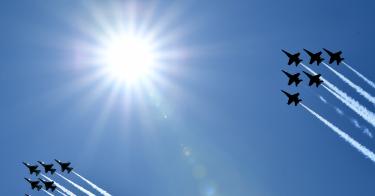The defense budget is an unusual investment—spending resources on something the country doesn’t want to use. Further, the more it invests in modernizing its military, the less likely it is to be used.
The goal of defense dollars is to build a force capable of deterring our adversaries—through both conventional and strategic means—by changing their cost-benefit analysis of taking any military action against our nation’s interests.
When deterrence succeeds, as it largely has for the last 75 years, it increases global stability and prompts countries to rely on nonmilitary means to advance their priorities.
In this regard, our defense budget signals to both adversaries and allies alike the degree of the American commitment to its interests abroad. It demonstrates our willingness to stand by our word with treasure and blood. It is what breathes life into our National Defense Strategy.
That is why any conversation on “how much to spend” needs to start at our strategy for the use of the military tool.
Rep. Adam Smith, Washington Democrat and chairman of the House Armed Services Committee, made this exact point recently when discussing the future of the defense budget.
“I want a conversation about what’s the strategy, what’s the plan going forward,” Mr. Smith said, while talking to the progressive wing of his party that tried twice this year to cut the defense budget by 10% without any discussion of our strategy or plan.
The current strategy was released in early 2018 and states that we are currently in “an increasingly complex global security environment, characterized by overt challenges to the free and open international order and the reemergence of long-term, strategic competition between nations.” The strategy states that Russia and China are the two main challenges to the free and open international order.
The strategy has received praise from both sides of the aisle, and both parties seem to understand the challenges that Russia and China present to U.S. interests at home and abroad.
Right now, this competition is mainly nonmilitary precisely because our military is currently unmatched in most areas and capable of deterring direct military action by imposing high enough costs on any adversary.
America’s conventional and strategic deterrence has served to create and sustain an unprecedented period of global stability. In an era of great power competition, maintaining this equation requires that we build and maintain our military strength.
Maintaining a military fully capable of deterring our adversaries requires constant tending. Historian Robert Kagan makes the analogy that maintaining the international order is like gardening, requiring constant attention—pulling weeds and clearing flower beds.
For defense, the upkeep involves restoring lost readiness, upgrading aging weapon systems, developing contemporary management practices, forging deeper relationships with our allies, and making sure the force is sized appropriately for the challenges of the next decades.
The enormousness of these tasks is why the Congressional Bipartisan Commission that evaluated the defense strategy, as well as successive defense secretaries, have called for increases in the defense budget of 3-5% above inflation through 2023.
Organizing, training, and equipping a great power’s armed forces for an uncertain future is not a cheap or simple task. The country expects the nation’s military to be unmatched in the battlefield and to accomplish its goals with minimal loss of life.
However, as former Secretary of Defense James N. Mattis constantly reminded the public: “America has no preordained right to victory on the battlefield.”
Victory in the battlefield, like deterrence, requires constant development and innovation to stay ahead of adversaries. If the goal is to overcome the challenges being created by our adversaries, we need to dedicate the proper resources to the task, both in time and in money.
Allowing either conventional or strategic deterrence to atrophy due to the lack of investments will only invite our adversaries to expand the competition into the military realm.
This piece originally appeared in the Washington Times



